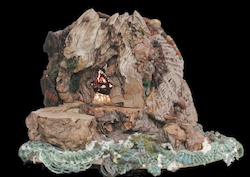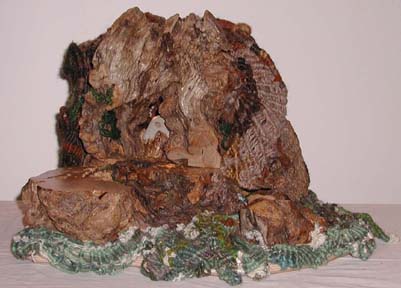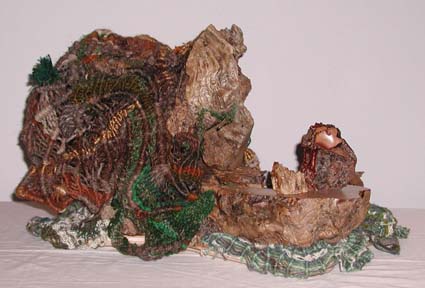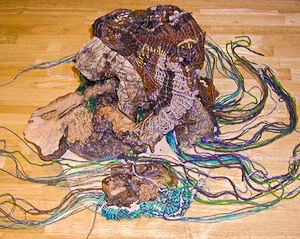| Odyssey | Spirit Caves | Mom's Bones | Tikkun Olam | Weaving | Totems |
Cave of the Cyclops
11"h x 17"w x 20"d
Eucalyptus, wire, varnish, manzanita, fiber, birch , sharp stick, stone. wooly sheep
.jpg)
Cyclops' Cave with wooly sheep near the entrance
This story of Odysseus and the One-eyed Cyclops is one of the more elaborate travel tales in the travelog Odysseus narrates to his hosts, the Phaeacians of Scheria, his last stop on the way home. Odysseus tells this tale to the Phaeacians at their invitation, so although Homer is the author of the bigger story we know as Homer's Odyssey, within the story Odysseus becomes a teller-of-tales in his own right. As we see how compact the story of the Lotus-eaters is in comparison with the tale of the Cyclops, it is not hard to imagine that a poet hired to sing the old stories, could expand or condense his repertoire, depending on how long his stay and in response to what he hears during the day in different locations. Many of the singer/poets whom Homer creates as characters within the larger poem are resident minstrels, but it appears from this section of the Odyssey that a traveler could also earn his keep on the road spinning a yarn, like today's radio performers, Garrison Keillor in America with Prairie Home Companion, or Canada's Stuart McLean and the Vinyl Café.
The narrative summary that I include for this sculpture is detailed in order to give viewers/readers/listeners who are less familiar with the Odyssey a feel for the exquisitely integrated details, the vivid descriptions, textures and nuances, and notable responses of the characters in the face of novelty, pain, terror, irony, and humor, on both sides, monster and man. What we miss in translation is the amazing onomatopoeia of the Greek, where, for example, the "s" sounds of the words in the scene describing the blinding of the Cyclops allow the listener to hear the sizzle of the eyeball and the searing heat of the fire that renders white-hot the wooden poker Odysseus and his men will grind into that one central eye.
Needing provisions, Odysseus moors near an island abundant with life. The twelve crews under his command easily beach their ships, hunt goats, feast and rest. Odysseus however, has plans. He orders all but the crew of his own ship to remain on the beach while he and trusted companions in his own ship sail across the strait to a cavern rousing his curiosity. Mooring out of sight, he chooses twelve men from the ship to accompany him and commands those remaining on board to wait at the ready. He tucks among his provisions for the trip a skin of the powerful Ismarian wine he received from the Ciconian priest, Maris, just in case....
The cave is open when Odysseus and his men arrive. It looks lived in but the host is not home. The men suggest stealing supplies then high-tailing it back to the ship, but this time it is Odysseus’s turn to doddle. He hopes for guest gifts from his unknown host. While they wait, his hungry men help themselves to the massive wheels of rich cheese.
.jpg)
Suddenly, an immense one-eyed mountain of a shepherd enters, dressed in shaggy skins, a log-boom’s worth of firewood in his arms, and leading a flock of thick-wooled sheep. The men scatter to the dark margins of the cave. The Cyclops sorts and pens some of his herd inside, having already penned some outside the cave, then he powers a huge stone across the mouth of the cave. Odysseus estimates two dozen carts, with horses and men, would barely budge the immense stone, even if it were broken into rubble. The Cyclops builds a fire in the cave, then pulls up a stool and begins to milk the sheep. There is no escape.
Odysseus comes forward, prevailing upon the orb-eyed giant to honor the laws of Zeus for hospitality to strangers, but the Cyclops is suspicious. He wonders if these invaders are guests, as Odysseus claims, or rather as he suspects, pirates and thieves. A son of the sea-god Poseidon, the Cyclops denies any obligation to honor the host/guest laws of his father’s little brother Zeus. He is not worried about customs, because his tribe honors few. Each man is the law unto his own house, and none sit in council. Instead of offering a gift, he snatches up two of Odysseus men from the shadows, bashes their heads on the ground and rips their bodies to pieces, as we might a cinnamon pull-apart or a buffalo wing. He then swallows them raw. Feigning curiosity as he licks his lips, he slyly enquires where Odysseus harbors his ship. Odysseus tells a lie, claiming his ship was destroyed. The Cyclops falls asleep. Odysseus’s remaining men weep while Odysseus strategizes how to escape.

His men entreat, “Why don’t we just kill the giant?”
Odysseus responds, pointing to the blocked mouth of the cave, “Because if we do, we will never get out of here.” As if understanding that possibility himself, the giant shuts them in the cave, making sure the huge stone is securely blocking their escape when he leaves the next day with the flocks. The captives carve a six-foot log into a sharp stake. When their captor returns at dusk from pasturing, he is even more suspicious, and brings all his flocks inside, even his largest, prize ram. He covers the mouth of the cave again. Feeling secure, he eats more of Odysseus’s men, and Odysseus graciously offers him the powerful Ismarian wine. When the Cyclops is thoroughly drunk, the stealthy Odysseus introduces himself. “Outis is my name.” (Depending on the case of the word's use in the sentence, the name sometimes becomes oudenos, more similar to the sound of Odysseus. Outis means “Nobody” in Greek. The Cyclops is not impressed, and no match for the wine, he promptly falls asleep again, his head lolling to the side. Odysseus and his men burnish the point of the heavy stake they have fashioned in the embers of the fire until the point is white-hot. All six grip the stake like a battering ram and thrust it smoldering into the single eye socket of the sleeping giant. They rotate it like a drill until the eyeball sizzles, then boils, and finally pops.
The Cyclops wakes screaming with pain. Though his is a land with no laws and no council, the screams rouse his neighbors who call back , “Who is with you? Who has hurt you?” To which the Cyclops responds, “Nobody is here and Nobody hurt me.” So his neighbors roll over and fall back to sleep while the Cyclops, head throbbing, blood pouring down his face, gropes through the inner darkness for those who blinded him. He hears them rustling near his bed but unable to see, he cannot catch them. When he falls back asleep, Odysseus unties the willow withes that hold together the Cyclops’ bed to prepare the next part of his escape plan.

Cyclops' cave, blocked with stone |

Blind, the Cyclop emerges |
In the morning, the sheep bleat even more loudly than usual, yet as the Cyclops readies them for pasture, he wants to make sure his prisoners do not escape. He slides away the stone from the opening only enough for the herd to file past while he runs his hands along their backs. He does not want "Nobody" or anyone else to escape on the backs of the sheep! His big rough hands cannot feel through the thick wool to the thin willow withes that Odysseus has woven into slings suspended beneath the rams to carry out his few remaining, trembling men. Unable to secure himself, Odysseus grips the thick matted wool on the underside of the prize ram, whose back the Cyclops checks even more carefully for poachers. Out of the cave, Odysseus and his men hurry silently toward the ship. Only when they set sail does Odysseus succumb to a sudden flush of victory. Despite his men’s warning that this is one time he should keep his mouth shut, he calls out, taunting the railing monster, and revealing his real name, as action which gives away not only his identity, but the ship’s position on the sea. The blind Cyclops tosses a huge stone that lands in front of the ship and creates a gigantic wave, pushing the ship back toward the shore.
Only then does the wounded Cyclops recall an old prophecy that an "Odysseus" would one day blind-side him… “But I thought it would be some huge, worthy giant stronger than I,” he whines back at Odysseus, “not a puny human runt like you.” He rips a peak off the mountain that binds his cave and hurls again, this time just missing the rudder at the stern of the fugitives' ship.
The Cyclops curses Odysseus, beseeching his own father Poseidon to avenge his wound by killing Odysseus, or if for some unfathomable reason he cannot be killed, then to make his journey home cruel, long and lonely, causing him to lose all his ships, men and booty, and arrive home to circumstances as painful as the blinding wound the Cyclops has endured. Poseidon hears his son’s curse and resolves to make the trickster’s journey home a living hell. Puns play throughout this piece. Curiously, in addition to the pun in "Nobody" or "No one", by which name the Cyclops first comes to know Odysseus, another possible pun on the name of Odysseus, who escapes by holding on to the underside of the prize ram, is ‘upodusetai, from a Greek word 'upoduo,' as in Odusseis, as the name Odysseus would be transliterated more directly from the ancient Greek. Thus the stealthy aspect of Odysseus hidden within the letters of his name, also suggests a quality of his character, highlighting the capacity of Odysseus for disguise, as in " conceaingl oneself under," as well as "coming out from under,” to reveal oneself (c.f. Liddell and Scott, Greek-English Lexicon, and Autenreith, A Homeric Dictionary)! So many levels: visual, mataphoric, poetic, and linguistic aspects collaborate within this story! Something for everyone! A story well told.
____________________________
Have you ever provoked or wounded someone on purpose? Stolen what you might later be offered, if only you had revealed your need? To what effect? How do you respond in the face of fear? Dread? Do you derive any significance in your life from your name? In your own life, how might you "come out from under"? For many years I was a "secret" artist, as writer and sculptor. I "stole" time in the late evenings when my children were asleep, and I should have been too! The art was my solace, though, and by keeping it to myself, I was able to keep control in at least one realm of my life! Mom's Bones, a story on this website, tells a little of that story. This website is my attempt to "come out from under."
I recently spoke to a man who had been homeless for many years and had recently been offered a rent-controlled apartment and a disability pension. He was having terrible difficulty keeping his new apartment clean, tidy, and bug-free. Living on a piece of cardboard in the gutter of an alley had left him without any of the habits considered necessary for "the good housekeeping seal of approval" ang the cockroaches took advantage of every opportunity.. His placement was under threat because of his inability to keep the place clean. Old habits of neglect undermined his still-forming intention to make this new placement his home. Out on a walk, he met a man, a father, who had named his son the surname of the recently homeless fellow. The father said he had named his son thus because the name meant "keeper of the household." The newly housed fellow reported to me that with the support from this new sense of his name, he felt strengthened in becoming a better "keeper" of his own new home. As for me, with the name Penelope, which I have gradually grown into, people have wondered how my own name, the same as the wife of Odysseus, might have played me, in this continuing project of "Weaving Odysseus Home."!

.jpg)
The Creative Challenge of the Cyclops Sculpture
The Cyclops sculpture was the second to be created, and again was experimental, because I had no idea yet that I would be creating a series. It was the wood that suggested the scene: some fragments of rough roots and worm-riddled stumps I had found, with their unusual bold markings and natural patina. They called for the creation of a cave, but one piece was just large enough to create the front of the cave with a dramatic opening that would serve as the mouth of the cave, but there was no cave attached! If I wanted this piece to front a cave, I would have to create the cave myself. And the other piece I simply could not resist. Its wormy trenches resembled the eroding sandstone bluffs of Torrey Pines State Park near my home in San Diego, at a time when my own neighborhood was being eaten up by powerful university-related institutions wanting to take over the neighborhood open space.
The challenge that I set myself was to work with the Hard and the Soft, to mimic in soft fiber the powerful textures of these rugged bits of wood that Nature had so exquisitely sculpted. To the left above is a small photo-cut of the wood itself, varnished, but otherwise mostly unworked. To the right is a photo of the sculpture in process, as I try to find ways, with knotting, texture, and color, to create a cave and then to connect the cave with a surrounding landscape, creating a unified piece from the various bits of wood, knot by knot, with textures and shades of my extensive pallet of yarns. Many of the yarns had been purchased back in Boston in the mid-seventies, when the artist who first taught me to weave and knot organized a trip to the bankrupt mills of Pawtucket, where we were able to purchase sturdy woolen rug yarns for a dollar a pound, and novelty slubs in shiny synthetic fibers for double that. It was my one personal splurge in my decade in Boston -- an amazing selection that has for the most part determined the pallet of my own weaving since. Thus, with wood fragments appearing from almost anywhere, and with my own shelves of enduring yarn, I am able to continue to work my art with little monetary investment. That capability leaves me free to continue with my projects without acruing initial debt, and to contemplate keeping some of my series of works together, as teaching "installations" which allow the art to do its powerful work, in the case of this series, opening the ancient story of the Odyssey to the light and life of the present!
In the Homeric description, the sea in the region of the Cyclops is more grey, not so "wine-dark" as in other locations, so I have incorporated more grey-greens wools, and cloudy grey synthetic shiny threads into the off-loom weaving and knotting that surrounds this side of the sculpture. The cave itself is fashioned around a series of armatures rather like the frame for the covered wagons carrying settlers across this vast continent centuries ago. If you scroll up to the sculpture entitled "Blind, the Cyclops emerges," you will see the rough Cyclops, his eye still bloody, a chunk of the mountain by his side, ready to toss on the tauting guest who indeed has robbed him blind.